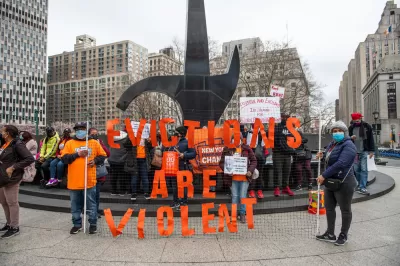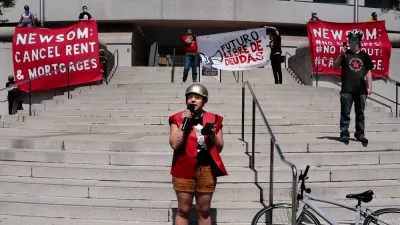Rental assistance spending in June surpassed the entire year's total so far, but there's still a long way to go.

"Emergency rental relief reached far more tenants and landlords in June than in previous months, reflecting delayed progress as the Biden administration, states and cities attempt to stave off an eviction crisis later this summer," reports Rachel Siegel.
As much money was paid to households in need of assistance in June as January through May combined, according to Siegel. Despite the progress, the pace of relief is slow relative to the amount of money available to support households through the economic consequences of the pandemic:
But housing experts caution there is a long way to go. Only about $3 billion was spent on rent, utilities and arrears through June — just a fraction of the $46 billion, in total, Congress appropriated for emergency rental aid. The vast majority of the money has not been spent while states and cities struggle to prop up programs that get money out the door.
Diane Yentel, president and chief executive of the National Low Income Housing Coalition, is quoted in the article noting that many states and cities have yet to provide any assistance to renters in need.
Indeed, Treasury data released Wednesday shows spotty progress. Some states saw encouraging jumps — the state of Illinois went from reporting zero assistance in the first five months of the year to $95.4 million in June, in large part because state officials took so long to build the program. California’s spending more than doubled in June to $74.4 million, up from $30.2 million in May.
Other places continued to lag behind or didn’t see major increases in spending, according to the Treasury data. Idaho paid out $1 million in rental assistance in May, and $1.1 million in June. Nevada paid out $2.6 million in May, then paid out less — $700,000 — in June.
For details about why some states have suddenly ramped up spending, click through to the source article.
For more reading on how to speed up rental assistance programs, see a recent article that listed three ideas to accomplish that goal.
FULL STORY: Rental relief programs ramped up in June, but fears mount that momentum may be coming too late

Planetizen Federal Action Tracker
A weekly monitor of how Trump’s orders and actions are impacting planners and planning in America.

Chicago’s Ghost Rails
Just beneath the surface of the modern city lie the remnants of its expansive early 20th-century streetcar system.

San Antonio and Austin are Fusing Into one Massive Megaregion
The region spanning the two central Texas cities is growing fast, posing challenges for local infrastructure and water supplies.

Since Zion's Shuttles Went Electric “The Smog is Gone”
Visitors to Zion National Park can enjoy the canyon via the nation’s first fully electric park shuttle system.

Trump Distributing DOT Safety Funds at 1/10 Rate of Biden
Funds for Safe Streets and other transportation safety and equity programs are being held up by administrative reviews and conflicts with the Trump administration’s priorities.

German Cities Subsidize Taxis for Women Amid Wave of Violence
Free or low-cost taxi rides can help women navigate cities more safely, but critics say the programs don't address the root causes of violence against women.
Urban Design for Planners 1: Software Tools
This six-course series explores essential urban design concepts using open source software and equips planners with the tools they need to participate fully in the urban design process.
Planning for Universal Design
Learn the tools for implementing Universal Design in planning regulations.
planning NEXT
Appalachian Highlands Housing Partners
Mpact (founded as Rail~Volution)
City of Camden Redevelopment Agency
City of Astoria
City of Portland
City of Laramie




























